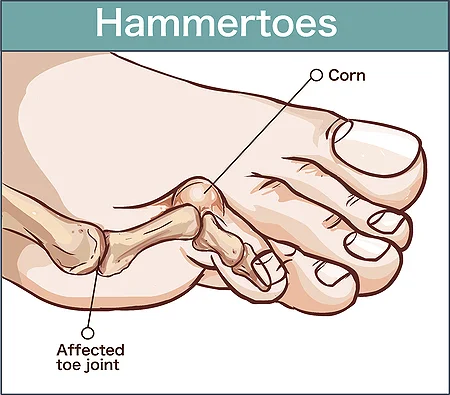Table of Contents
Introduction - Hammertoe
Sometimes a muscle imbalance causes a hammertoe, or a bending of the toe at the first joint. The bent toe looks like an upside-down “V”. The abnormal imbalance of muscles increases the pressure on the toe’s joints and tendons.
A flexible hammertoe is still moveable at the joint and can be treated, but a rigid hammertoe may become immobile.
Trauma such as from an injury can cause a hammertoe, as can heredity, arthritis, and wearing shoes that are too tight.
Problems With Your Little Toes
Your little toes help balance and propel your body when you move. As your foot flattens, the little toes bend to grip the ground. Then they straighten, acting like levers to help push your foot so you can walk, run, or dance. But if the front of your foot is wide, you may develop a problem known as a hammer toe. Hammer toes are the little toes that buckle or curl under. Over time, these toes may hurt and make movement more difficult. But you don’t have to live with pain. With your doctor’s help, even severe hammer toes can usually be treated so you can move more easily.
What Are Hammer Toes?
Types of hammer toes
A Flexible Joint
A Rigid Joint
Hammertoe Symptoms
Symptoms of a hammertoe include:
- Pain at the top of the toe because of shoe pressure
- Corns on top of the bend
- Swelling and redness of the joint
- Restricted motion of the joint
- Pain extending to the ball of the foot at the base of the hammertoe
Hammertoe Treatment
You can relieve the discomfort of a hammertoe by padding the area to reduce friction. Switch to shoes with a deep, wide toe box and avoid high heels. Icing can help with inflammation.
But a hammertoe cannot be cured without professional help from a podiatrist.
To confirm our diagnosis, we will take an X-ray of the area. Treatment options include:
- Padding and taping to minimize pain and relieve stress.
- Anti-inflammatory medications and/or cortisone injections to reduce pain and inflammation.
- Custom-fitted orthotics to reduce symptoms and prevent worsening of the deformity.
There are several surgical options if necessary.
Physical Exam
Testing
Treatment
Flexible Joints
Rigid Joints
After Surgery
The First Few Weeks
Proper Shoes
Hammertoe Prevention
You can prevent hammertoes from forming or getting worse. Wear supportive shoes and avoid those with pointed or narrow toe boxes. Orthotics can help prevent the development of hammertoes or slow their progression.



